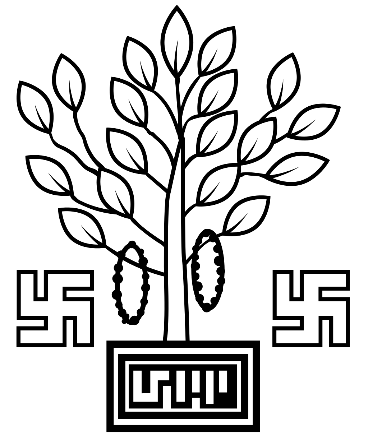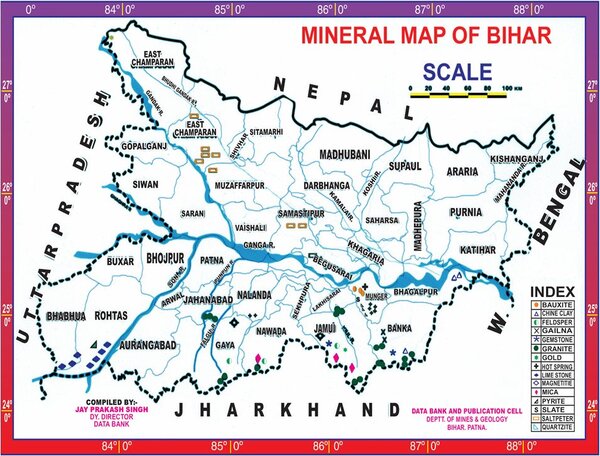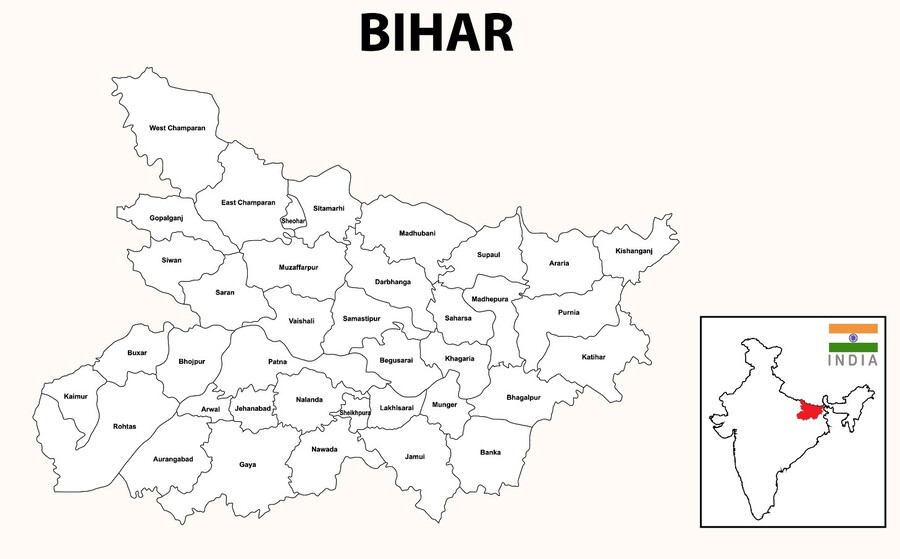Bihar at a Glance- Culture, Economy, Symbols, Geography, Tourism, Politics and Demography of Bihar
General Information about Bihar
- Bihar is the third most populous state of India and 12th largest in terms of area.
- It is bounded by Nepal in the north and by Jharkhand in the south. Uttar Pradesh borders the state in the west and West Bengal in the east.
- The Bihar plain is divided into two unequal halves by the river Ganga which flows through the middle from west to east.
- Sonepur is located at the confluence of rivers Ganga and Gandak.
- The state was formed on 22 March 1912 and gained statehood on 26 January 1950.
- Jharkhand was carved out of southern Bihar on 15 Nov 2000 to form a separate state.
State Symbols of Bihar
- State song- Mere Bharat Ke Kanth Haar
- State Mammal- Gaur (Mithun)
- State Bird- House Sparrow (Passer Domesticus)
- State Flower- Kachnar (Phanera Variegata)
- State Fruit- Mango (Magnifera Indicia)
- State Tree- Peepal Tree (Ficus Religiosa)
- State Emblem-

Geography of Bihar
Bihar is located in the eastern part of the country (between 83°-30' to 88°-00' longitude). It is an entirely land–locked state, although the outlet to the sea through the port of Kolkata is not too far away.
Climate and Soil
The climate in Bihar is a continental monsoon type of climate (Cwa) due to its great distance from the sea. The average temperature here is 27°C and the average rainfall in 975.86mm.
The factors affecting the climate of Bihar are:
- It extends from 22°N to 27°N latitude i.e. location is tropical to sub tropical.
- The Himalayan Mountains in the north have a significant bearing on the distribution of monsoon rainfall in Bihar.
- Bihar joins the Ganga delta and Assam.
Seasons
- Cold weather season - December to February.
- Hot weather season – March to May.
- Southwest monsoon – June to September.
- Retreating southwest monsoon – October to November.
Soils
The plains of Bihar consist of thick alluvial mantle. The soil is young and rejuvenated by continuous deposition of silt, clay and sand brought down by flowing rivers. The soil here lacks phosphoric acid, nitrogen and humus, but is rich in potash and lime. There are three major types of soil in Bihar:
- Piedmont Swamp Soil - northwestern part of west Champaran
- Terai Soil – northern part of the state along the border of Nepal
- The Gangetic Alluvium – the plain of Bihar is covered by gangetic alluvium (both new as well as old).
Major crops grown in Bihar: paddy, wheat, lentils, sugarcane, jute (hemp, related to the marijuana plant, but a source of tough fibers and "gunny bags"). Cane grows wild in the marshes of West Champaran.
Major fruits grown in Bihar are: mangoes, banana, jack fruit and litchis
Rivers, Lakes and Waterfalls
There are many beautiful Lakes in Bihar, some of these are as follows:
-
- Kanwar Lake in Begusarai
- Muchalinda Lake in Bodhgaya
- Saraiya Man Lake in Bettiah
- Kharagpur Lake -3 km away from Munger
- Moti Jheel in Motihari
- Ghorakatora Lake at Rajgir
- Pandu Pokhar at Rajgir
- Indrapuri Barrage or Sone Barrage on Son River is situated in Rohtas district.
- Some of the more famous waterfalls in Bihar are:
- Kakolat Falls in Nawada
- Tekhar Waterfall in Kaimur
- Karkat Waterfall in Kaimur
- Tutla Bhawani or Titual Dham in Rohtas
- Manjhar Kund in Rohtas
- Dhua Kundin Rohtas
- Rivers of Bihar- Ganga, Bagmati, Gandak, Bhuri Gandak, Adhwara group of rivers (originate from foothills of Nepal), Ghagra, Phalgu River, Kosi River, Mahananda, Punpun, Son, Sapt Koshi
National Parks and Wildlife Sanctuary in Bihar
- Valmiki National Park Wildlife Sanctuary- It is located in the West Champaran district. It was a wildlife sanctuary till 1978. It is famous for the Royal Bengal Tigers, rhinoceros and bison. A large number of flying fox (a kind of bat) can also be seen here.
- Kaimur Wildlife Sanctuary- Kaimur- It is the largest wildlife sanctuary in Bihar. It is famous for black buck. It was established in 1992.
- Pant or Rajgir Wildlife Sanctuary in Nalanda Forest Division- The sanctuary is enclosed by five peaks of the Rajgir hills – Vipulgiri, Ratnagiri, Udaigiri, Sonagiri and Baibhavgiri.
- Vikramshila Gangetic Dolphin Wildlife Sanctuary- It is famous for Dolphins. It was established in 1991. It is located in Bhagalpur.
- Kanwar Lake Bird Sanctuary- It was established in 1987. It is located in Begusarai.
- Bhimbandh Wildlife Sanctuary- It was established in 1975 and is located in Munger.
- Gautam Buddh Wildlife Sanctuary- It was established in 1976. It is located in Gaya district of Bihar and Koderma district of Jharkhand.
- Nagi Dam Wildlife Sanctuary- It is located in Jamui District. It is the smallest bird sanctuary in Bihar.
- Nakti Dam Bird Sanctuary- It is close to Nagi Dam. Nagi Dam and Natki Dam are man-made lakes that have been declared as Bird sanctuaries.
- Udaypur Wildlife Sanctuary- It is located in West Champaran district. It was established in 1978. It is located on an oxbow lake in the floodplain of the Gandaki River.
Economy-Natural Resources in Bihar
According to Economic Survey of Bihar 2018-19, the growth rate of Bihar’s economy in 2017-18 was 11.3 percent, the highest among all the states in India. High development expenditure by the state government, without compromising on its financial discipline was the major factor behind this growth. The GSDP of Bihar in 2017-18 was Rs. 4,87,628 crore at current prices. At constant (2011- 12) prices, the figure stood at Rs. 3,61,504 crore.
In 2016-17, the highest growth rate was recorded by tertiary sector (12.8 percent), followed by primary sector (9.8 percent) and secondary sector (4.2 percent).
As per these estimates, three most prosperous districts in Bihar are — Patna, Munger and Begusarai. On the other end, three most economically disadvantaged districts are — Madhepura, Supaul and Sheohar.
The cropping pattern, nearly unchanged over the years, reveals that Bihar is primarily a cereal economy, with more than 85 percent of its gross cropped area under cereals.
The major source of milk production in the state are cows which accounted for nearly 58.6 percent of the total milk production, followed by buffaloes (39.2 percent) and goat (2.2 percent).
This growth in agro-based industries in Bihar (19.2 percent) was almost five times the growth rate achieved across all states of India (3.6 percent).
Under the Mukhyamantri Kosi Mulberry Scheme, 7 districts- Saharsa, Supaul, Madhepura, Araria, Kishanganj, Katihar and Purnea in the Kosi region were selected for promotion of mulberry production.
Kushal Yuva Program (KYP) is part of one of the ‘Saat Nishchay’ (Seven Resolves) of the state government — ‘Aarthik Hal, Yuvaon ko Bal’. This programme is targeted at all aspirants in the age group of 15-28 years, with age limit relaxed for SC/ST (33 years), OBC (31 years), Persons with disability (33 years).
Saat Nischaya or Seven Resolves of the Bihar government are:
- Aathik Hal, Yuvaonko Bal
- Aarakshit Rozgar, Mahilaon ka Adhikar
- Har Ghar Bijli, Lagatar
- Har Ghar Nal ka Jal
- Ghar Tak Pakki Gali-Naaliyna
- Shauchalay Nirmaan, Ghar Ka sammaan
- Avsar Badhe, Aage Padhein
Forests and Wildlife
The forest in Bihar covers 7.27% of the geographical area of the State.
The state has got natural sal forests in the district of West Champaran in the terai region of shivaliks. Besides, Sal forests are abundant in the southern Bihar in the districts of Kaimur, Rohatas, Aurangabad, Gaya, Jamui, Munger and Banka. The West Champaran district has moist deciduous Sal forests while south Bihar has dry deciduous Sal Forests.
The important Tree species found in Bihar are Sal (Shorea robusta), Shisham, Teak, Gamhar, Kadamb, Semal, Neem, Peepal, Bargad, Arjun, Asan, Haldu, Mahua and Kend.
Wildlife Species: The important Terrestrial species are Tiger, Leopard, Bear, Hyena, Bison, Chital, Barking Deer etc. Besides, there are many varieties of Crocodile, Magars and Fishes, Gangetic turtles in River systems. Freshwater Dolphin is found in the Ganga, Kosi, Gandak, Mahanada and Paimar rivers of the state.
Minerals
Minor minerals like soil, sand and stone, and the major minerals of the state include granite, bauxite, quartzite, pyrite, mica and limestone are present in Bihar. Bihar is the principal holder of the country's pyrite resources and possesses 94% of resources.
The important minerals in Bihar are
- Coal in Rajmahal coalfield;
- Limestone in Kaimur (Bhabhua), Monghyr and Rohtas districts;
- Mica in Nawada district;
- Quartz/silica sand in Bhagalpur, Jamui, Monghyr and Nalanda districts;
- Quartzite in Lakhisarai, Monghyr and Nalanda districts;
- Talc/soapstone/steatite in Monghyr district;
- Bauxite in Monghyr and Rohtas districts;
- China clay in Bhagalpur and Monghyr districts;
- Felspar in Gaya, Jamui and Monghyr districts;
- Fireclay in Bhagalpur and Purnea districts;
- Gold in Jamui district;
- Granite in Bhagalpur, Gaya, Jahanabad and Jamui districts;
- Iron ore (hematite) in Bhagalpur district;
- Iron ore (magnetite) in Gaya and Jamui districts;
- Lead-zinc in Banka and Rohtas districts;
- Pyrites in Rohtas district

Key Statistics of Bihar –Census 2011
- It covers an area of 94,163 sq km and has a total population of 10,40,99,452. The most populous district of Bihar is Patna and the least populous district is Sheikhpura.
- As per of the 2011 census, Bihar is India's most densely-populated state. The population density in Bihar is 1,106 per sq kms.
- The lowest population density is in the Kaimur district while the highest population density is in Sheohar.
- Its capital and largest city is Patna.
- Sex Ratio: 918 females per thousand males
- Sex ratio is highest in Gopalganj (1,021) while it is lowest in Munger (876).
- The overall literacy rate in Bihar is 61.8%. The literacy rate is lowest in Purnia (51.08%) and highest in Rohtas (73.37%).
- Male literacy stands at 71.20% while female literacy stands at 51.50%.
- At 11.29%, Bihar has the second-lowest urbanisation rate in India after Himachal Pradesh.
Bihar Polity
- The Chief Minister of Bihar is the chief executive of the Indian state of Bihar. Current Chief Minister of Bihar is Nitish Kumar and current Governor is Phagu Chauhan.
- Deputy Chief Ministers- Renu Devi and Tarkishore Prasad
- There are total 38 districts in Bihar.
- Bihar has a bicameral legislature. It has 243 assembly seats and 75 legislative council seats.
- Bihar has 40 seats in the Lok Sabha and 16 seats in Rajya Sabha.
- The high court of Bihar is located in Patna.
- The official language of Bihar is Hindi.

List of Chief Ministers of Bihar
|
S. No. |
Chief Minister |
From |
To |
|
1 |
Krishna Sinha (Shri Babu) |
2-Apr-46 |
31-Jan-61 |
|
2 |
Deep Narayan Singh |
1-Feb-61 |
18-Feb-61 |
|
3 |
Binodanand Jha |
18-Feb-61 |
2-Oct-63 |
|
4 |
K. B. Sahay |
2-Oct-63 |
5-Mar-67 |
|
5 |
Mahamaya Prasad Sinha |
5-Mar-67 |
28-Jan-68 |
|
6 |
Satish Prasad Singh |
28-Jan-68 |
1-Feb-68 |
|
7 |
B. P. Mandal |
1-Feb-68 |
2-Mar-68 |
|
8 |
Bhola Paswan Shastri |
22-Mar-68 |
29-Jun-68 |
|
9 |
Harihar Singh |
26-Feb-69 |
22-Jun-69 |
|
10 |
Bhola Paswan Shastri |
22-Jun-69 |
4-Jul-69 |
|
11 |
Daroga Prasad Rai |
16-Feb-70 |
22-Dec-70 |
|
12 |
Karpoori Thakur |
22-Dec-70 |
2-Jun-71 |
|
13 |
Bhola Paswan Shastri |
2-Jun-71 |
9-Jan-72 |
|
14 |
Kedar Pandey |
19-Mar-72 |
2-Jul-73 |
|
15 |
Abdul Ghafoor |
2-Jul-73 |
11-Apr-75 |
|
16 |
Jagannath Mishra |
11-Apr-75 |
30-Apr-77 |
|
17 |
Karpoori Thakur |
24-Jun-77 |
21-Apr-79 |
|
18 |
Ram Sundar Das |
21-Apr-79 |
17-Feb-80 |
|
19 |
Jagannath Mishra |
8-Jun-80 |
14-Aug-83 |
|
20 |
Chandrashekhar Singh |
14-Aug-83 |
12-Mar-85 |
|
21 |
Bindeshwari Dubey |
12-Mar-85 |
13-Feb-88 |
|
22 |
Bhagwat Jha Azad |
14-Feb-88 |
10-Mar-89 |
|
23 |
Satyendra Narayan Sinha |
11-Mar-89 |
6-Dec-89 |
|
24 |
Jagannath Mishra |
6-Dec-89 |
10-Mar-90 |
|
25 |
Lalu Prasad Yadav |
10-Mar-90 |
28-Mar-95 |
|
26 |
Lalu Prasad Yadav |
4-Apr-95 |
25-Jul-97 |
|
27 |
Rabri Devi |
25-Jul-97 |
11-Feb-99 |
|
28 |
Rabri Devi |
9-Mar-99 |
2-Mar-00 |
|
29 |
Nitish Kumar |
3-Mar-00 |
10-Mar-00 |
|
30 |
Rabri Devi |
11-Mar-00 |
6-Mar-05 |
|
31 |
Nitish Kumar |
24-Nov-05 |
19-May-14 |
|
32 |
Jitan Ram Manjhi |
20-May-14 |
22-Feb-15 |
|
33 |
Nitish Kumar |
22-Feb-15 |
Incumbent |
|
|
President's rule |
7-Mar-05 |
24-Nov-05 |
|
|
President's rule |
11-Feb-99 |
9-Mar-99 |
|
|
President's rule |
28-Mar-95 |
4-Apr-95 |
|
|
President's rule |
17-Feb-80 |
8-Jun-80 |
|
|
President's rule |
30-Apr-77 |
24-Jun-77 |
|
|
President's rule |
9-Jan-72 |
19-Mar-72 |
|
|
President's rule |
6-Jul-69 |
16-Feb-70 |
|
|
President's rule |
29-Jun-68 |
26-Feb-69 |
List of Governors of Bihar
|
Name of Governors |
From |
To |
|
Shri Jairamdas Daulatram |
15/08/1947 |
11/01/1948 |
|
Shri Madav Shrihari Aney |
12/01/1948 |
14/06/1952 |
|
Shri Ranganath Ramchandra Diwakar |
15/06/1952 |
05/07/1957 |
|
Dr. Zakir Hussain |
06/07/1957 |
11/05/1962 |
|
Shri M.A.S. Ayyangar |
12/05/1962 |
06/12/1967 |
|
Shri Nityanand Kanungo |
07/12/1967 |
20/01/1971 |
|
Shri Justice U.N. Sinha (Offg) |
21/01/1971 |
31/01/1971 |
|
Shri Devkant Baruah |
01/02/1971 |
04/02/1973 |
|
Shri Ramchandra Dhondiba Bhandare |
04/02/1973 |
15/06/1976 |
|
Shri Jagan Nath Kaushal |
16/06/1976 |
31/01/1979 |
|
Shri Justice K.B.N. Singh (Offg.) |
27/05/1978 |
26/06/1978 |
|
Dr. Akhlaq-ur-Rahman Kidwai |
20/09/1979 |
15/03/1985 |
|
Shri Pendekanti Venkatasubbiah |
15/03/1985 |
25/02/1988 |
|
Shri Govind Narain Singh |
26/02/1988 |
24/01/1989 |
|
Shri Justice Dipak Kumar Sen (Offg) |
24/01/1989 |
28/01/1989 |
|
Shri Ramchandra D. Pradhan |
29/01/1989 |
02/03/1989 |
|
Shri Jagannath Pahadia |
03/03/1989 |
02/02/1990 |
|
Shri Justice G.G. Sohoni (Offg) |
02/02/1990 |
16/02/1990 |
|
Shri Mohammad Yunus Saleem |
16/02/1990 |
13/02/1991 |
|
Shri B. Satyanarayan Reddy (Offg) |
14/02/1991 |
18/03/1991 |
|
Shri Mohammad Shafi Qureshi |
19/03/1991 |
13/08/1993 |
|
Dr. Akhlaq-ur-Rahman Kidwai |
14/08/1993 |
26/04/1998 |
|
Shri Sunder Singh Bhandari |
27/04/1998 |
15/03/1999 |
|
Shri Justice B.M. Lal (Offg) |
15/03/1999 |
05/10/1999 |
|
Shri Suraj Bhan (Offg) |
06/10/1999 |
22/11/1999 |
|
Shri Vinod Chandra Pande |
23/11/1999 |
12/06/2003 |
|
Shri Justice Mandagadde Rama Jois (Retd.) |
12/06/2003 |
31/10/2004 |
|
Shri Ved Prakash Marwah (Offg) |
01/11/2004 |
04/11/2004 |
|
Shri Buta Singh |
05/11/2004 |
30/01/2006 |
|
Shri Gopalkrishna Gandhi (Offg) |
31/01/2006 |
21/06/2006 |
|
Shri R. S. Gavai |
22/06/2006 |
10/07/2008 |
|
Shri R. L. Bhatia |
10/07/2008 |
28/06/2009 |
|
Shri Devanand Konwar |
29/06/2009 |
21/03/2013 |
|
Dr. D. Y. Patil |
22/03/2013 |
26/11/2014 |
|
Shri Keshari Nath Tripathi |
27/11/2014 |
15/08/2015 |
|
Shri Ram Nath Kovind |
16/08/2015 |
21/06/2017 |
|
Shri Keshri Nath Tripathi (Offg) |
22/06/2017 |
03/10/2017 |
|
Shri Satya Pal Malik |
04/10/2017 |
22/08/2018 |
|
Shri Lal Ji Tandon |
23/08/2018 |
28/07/2019 |
|
Phagu Chauhan |
Since 2019 |
Incumbent |
Bihar Culture
Festivals, Religion, Fairs
- Fairs and festivals have always been an essential part of life in Bihar. Some of the fairs are-
- Sonepur Cattle Fair is held on Kartik Poornima in the month of November.
- Malmas Mela
- Makar Sankranti Mela
- Pitrapaksha Mela- During Pitrapaksha Hindus worship their ancestors, and perform Shraddha ritual and do Pinda Daan. This is believed to bring salvation to the departed soul.
- Shrawani Mela is held in Deoghar (Jharkhand) where millions of devotees gather at the Baba Baidyanath Temple. This mela falls mostly in the months of July and August.
- Some famous dishes of Bihar are Litti Chokha, Sattu Sarbat, Kadhi Bari, Chana Ghugni, Pittha, Tilkut, Belgrami (Udwant Nagar), Kheer Makhana (Darbhanga), Silao Khaja (Nalanda), Dahi Choora, Malpua, Khoye Ki Laai (Barh), Bhujna.
- Chhath Pooja is the most important festival in Bihar, dedicated to the Sun and his wife Usha to thank them for bestowing the bounties of life on earth and to request the granting of certain wishes. It is purely dedicated to nature.
- Makar Sankranti marks the first day of the sun’s transit into the Makra i.e. end of the winter solstice and start of longer days.
- Basant Panchami is dedicated to goddess Saraswati. People dress in yellow attire and share yellow colored snacks and sweets.
- Mahashivratri is celebrated annually in honour of Lord Shiva.
- Other festivals celebrated in Bihar are Holi, Janaki Navmi, Ramnavmi, Buddh Purnia, Shab-e-Barat, Eid-al-Adha, Eid-Ul-Fitr, Muharram (by Muslim communities), Durga Puja, Janamashtmi, Diwali, Chitragoopt Pooja, Chehallum.
- Hindu Goddess Sita is believed to be born in the Sitamarhi district in the Mithila region of modern-day Bihar. Gautama Buddha attained Enlightenment at Bodh Gaya in Bihar. Vasupujya, the 12th Jain Tirthankara was born in Champapuri, Bhagalpur. Vardhamana Mahavira, the 24th and the last Tirthankara of Jainism, was born in Vaishali around the 6th century BC.
Music and Dance
- The classical music in Bihar is a form of Hindustani classical music. Famous musicians like Bharat Ratna Ustad Bismillah Khan and dhrupad singers like the Malliks (Darbhanga Gharana) and the Mishras (Bettiah Gharana) along with poets like Vidyapati Thakur have contributed to Maithili Music.
- The folk songs in Bihar are performed on various occasions like sohar - performed during childbirth, sumangali - associated with wedding, ropnigeet - performed during the season of sowing paddy, katnigeet - performed during the paddy harvesting season.
- Musical instruments of various kinds are common among various tribes and communities in this region. They comprise of the Dhol, Dhak, Dhanaka, Madal, Mandar or Madol, Nagara, flute, Pipahi (Shhehnai like), Jhanjh, clappers etc. Sometimes a C- shaped hom, Narsingha also called the Sakoa is used. Tumdak and Tamak are two percussion instruments played together.
- Famous Folk Dances of Bihar- Karma Dance, Jhijhia Dance, Kajari Song, Jhumar Dance, Magahi Jhumar Dance, Jharni Dance (Julaha community perform during Muharram), Jat-Jatin (Mithila and Kosi region), Jhumeri (Mithilanchal), Sohar Khelwana (celebrate child birth), Dhamar Jogira (Holi Dance), Krishi Nritya, Chaita (sung in Chaitra month), Nachni (dances with male partner Rashik), Natua (performed on Nagara, Dhol and Shenai)
Art and Craft
- Mithila region in northern Bihar is famous for Madhubani paintings or Mithila paintings. These paintings mostly depict nature and Hindu religious motifs, and the themes generally revolve around Hindu deities like Krishna, Ram, Shiva, Durga, Lakshmi, and Saraswati. Natural objects are also painted, along with scenes from the royal court and social events like weddings. The Miniature paintings make use of leaves or paper and depict the lives of Buddha or Mahavira.
- Manjusa art is a folk art of Bhagalpur, Bihar, and has been dated back to the 7th century. It is also called a scroll painting.
- Patna School of Painting or Patna Qalaam (Patna Kalam) or Company Painting is a style of Indian Painting, which existed in Bihar in the 18th and 19th centuries. This style combined elements of the Mughal and British styles of paintings so well, that it was called the Feringhee Kalam (the White man’s art).
- Tikuli Art originated in Patna.
- Papier mache is an ancient craft of Bihar that was used for the preparation of masks for different dance forms.
- The Pattharkatti region of Atri in Gaya is one of the major centres of stone craft in Bihar.
- Sujani (or Sujini) is one of the most popular forms of conventional art and craft prevailing in Bihar.
- Khatwa is the name given to appliqué works in Bihar. Khatwa is about designing by cutting one fabric and stitching the pieces to another fabric.
- Bihar is also famous for stone pottery, white metal statuettes, bamboo artifacts, wooden toys and leather goods. Wood inlay in which the craftsmen use different wood and metal to create inlaid designs for table toys, wall plaque and trays is also famous.
- In north Bihar, a special grass called Sikki is found which when dyed in bright colours and woven with the natural grass makes excellent attractive baskets, boxes and figures.
Language and Literature
- Hindi is the official language in Bihar. Maithili (including its dialect Bajjika), Bhojpuri, Angika and Magahi are also widely spoken in the state. Maithili is listed under the 8th Schedule of the Constitution of India.
- Raja Radhika Raman Singh, Shiva Pujan Sahay, Divakar Prasad Vidyarthy, Ramdhari Singh Dinkar, Ram Briksha Benipuri produced great works in Hindi literature.
- Vidyapati was a famous Maithali and Sanskrit poet and writer.
- Vaidhyanath Mishra (pen name Nagarjun) was known as Janakavi (people’s poet) was a Hindi and Maithali poet.
- Maila Anchal by Phanishwar Nath Renu is one of the finest examples of the regional novel.
- Bihar has a robust Bhojpuri-language film industry. The first film with Bhojpuri dialogue was Ganga Jamuna, released in 1961. Bhaiyaa, the first Magadhi film, was released in 1961.
Tourism
- Presence of religious, mythological and spiritual sites has led to the influx of tourists in Bihar. Some of the important sites in Bihar are as follows:
- Navalakha Palace in Rajnagar
- Kesaria Stupa in East Champaran
- Lomas Rishi Caves in Jehanabad
- Ashoka Pillar, Mud Stupa (Licchivi Stupa), Shanti Stupa in Vaishali
- Golghar in Patna
- Patan Devi Temple in Patna-oldest and one of the most sacred temples of Patna. It is one of the 51 Siddha Shakti Pithas in India.
- Mahavir Hanuman Temple
- Museums in Patna- Gandhi Museum, Patna Museum, Bihar Museum
- Agam Kuan in Patna
- Buddha Smriti Park in Patna
- Sabhyata Dwar in Patna
- Mahabodhi Temple, Bodhi Tree, Vishnupad Temple, Dungeshwari Cave Temple (Mahakala caves), Mangla Gaur Temple in Gaya
- Barabar Caves in Gaya
- The Archaeological Site of Nalanda Mahavihara (Nalanda University) is included among the world heritage list of UNESCO (2016).
- Vishwa Shanti Stupa (World Peace Pagoda) in Nalanda (ratnagiri hills)
- Jalmandir in Pawapuri
- Saptparni Caves near Rajgir
- Son Bhandar Caves (related to Jainism-ajivikas) in Rajgir
- Hotspring in Rajgir
- Venu Vana (Bamboo forest)
- Hiuen Tsang Memorial in Nalanda
- Munger Fort
- Bhaluni Dham Mandir, Chaurasan Temple are located in Rohtas
- Panth Pakar, Bagahi Math, Pupri Temple in Sitamarhi
- Tomb of Sher Shah Suri is in Sasaram in Rohtas




 Latest
Latest 



Comments